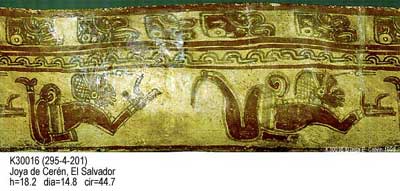
| FAMSI © 2001: Inga Calvin |
||
Rollout Photography of Polychrome Pottery from El Salvador
Research Year: 1997 Table of Contents
Introduction Funds from FAMSI permitted me to pursue my on-going research of Late Classic Period (A.D. 600 - A.D. 900) Maya vessels embellished with "pseudo-glyphs" or "glyphoids." As will be presented here, FAMSI Grant No. 96042 has allowed me to establish a database of rollout photographs of provenienced vessels decorated with "pseudo-glyphs" (glyph-like symbols that do not conform to the canons of Maya hieroglyphic writing as currently understood). The ceramics included in this corpus derive from sites in El Salvador, Honduras and Guatemala. It must be noted that this project could not have been conducted without the generosity of Justin Kerr who facilitated the creation of my rollout camera and whose system of K-numbers is used to reference these rollout images. Advances in the field of archaeology and epigraphy over the past 50 years have provided significant new understandings about the nature of Late Classic Period Maya society. In particular, great progress has been made in determining the nature of hieroglyphic writing and in providing new decipherments that help illuminate elite Maya history. Decipherment of the glyphs painted on Late Classic Period pottery has revealed information regarding the function and geographic and social origin of particular vessels and has provided insight about Maya beliefs, social structure, and elite interactions. A neglected component of Late Classic pottery epigraphic studies, however, has been analysis of the symbols defined as "pseudo-glyphs" or "glyphoids" (Longyear, 1944; 1952; Viel, 1983; 1993) because these signs do not share the same rules as conventional Maya hieroglyphics. General Categories of Pseudo-glyphs Although both conventional Maya hieroglyphs and pseudo-glyphs appear painted on ceramics as rim and body texts, symbols identified as pseudo-glyphs do not clearly convey a currently recognized meaning. However, as will be discussed in greater detail in my Ph.D. dissertation and as revealed by survey of this preliminary database, pseudo-glyphs form four general categories:
All of these categories are represented in this rollout sample. This corpus consists of images of vessels from the following sites:
Click to download the report in PDF format: Rollout Photography of Polychrome Pottery from El Salvador (2.90 MB) The PDF files require Adobe Acrobat Reader.
Submitted 07/01/1998 by: |
||
| Return to top of page | ||
|
Text links to all pages at this site are available at the FAMSI INDEX |
||

